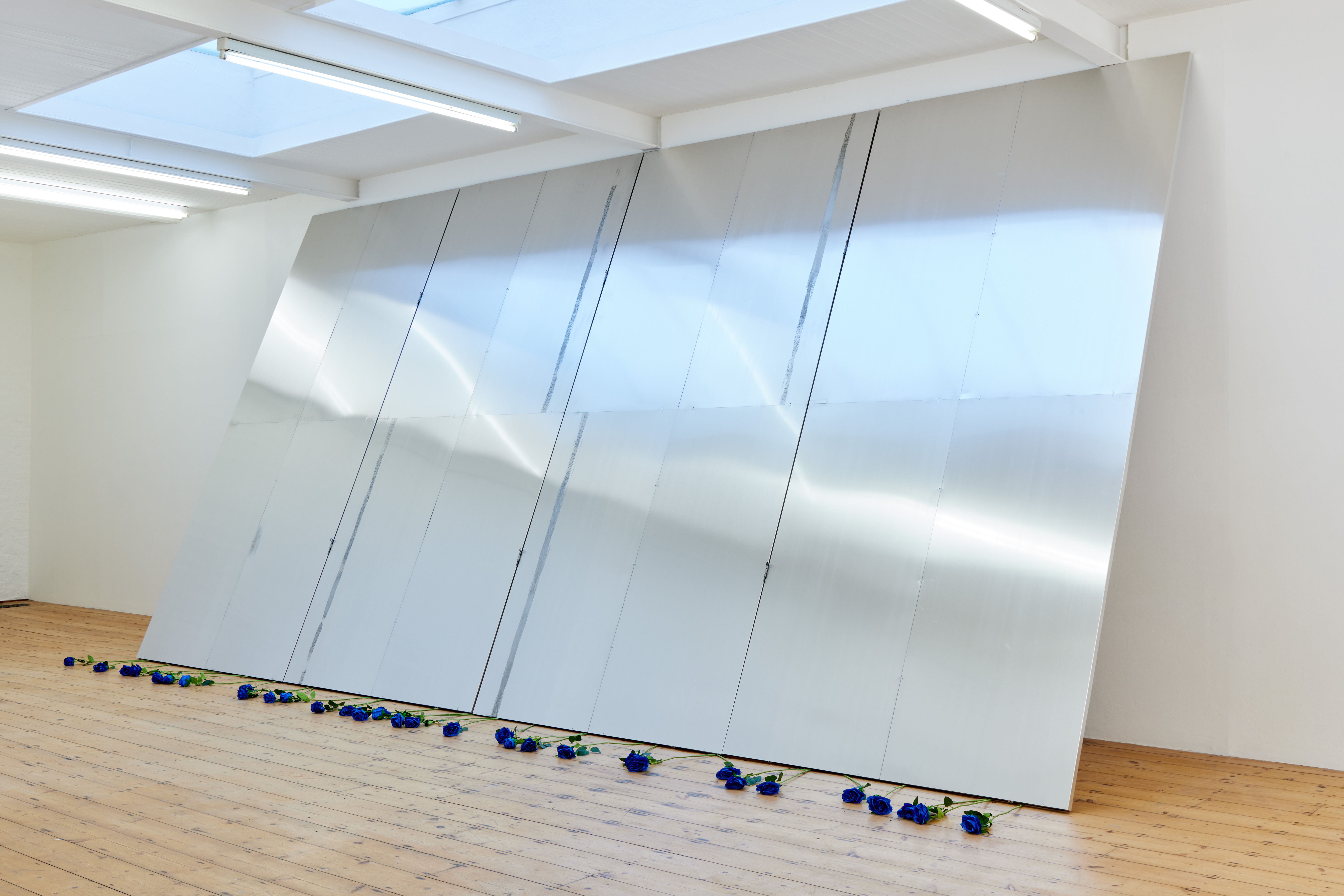
Sin City, 2023, Sitara Abuzar Ghaznawi. Auto Italia, London, UK. Courtesy the artist. Photographer: Henry Mills.
In Ghaznawi’s hallmark fashion, the title of her exhibition Sin City (2023), challenges the status quo about who, where and what we talk about. As an architectural noir, Sin City explores modern-day no man’s lands in global matters of conversation, contradiction and delineation.
The axis mundi (the point of departure) of modern urban planning, it can be argued, has the prosperity of either sin or virtue within its infrastructure as its central reference point. While the axis mundi is a universal reference to heaven and earth’s proximity, as a common motif in Islamic architecture it reassures the presence of the all-embracing and all-knowing in the ‘lowest’ (material) world. As contemporaneity moves away from vertical toward horizontal concerns, the main question becomes how the ‘peripheral’ is mediated. Inherently introverted spaces of public use are unequipped to retain the public, suggesting the metabolic release of the city’s vices in ‘sin cities’ – a cathartic mythical trope of blockbuster nature. Perhaps the apparent polarity between such concepts encourages quasi-egalitarian gazing, a redefined voyeurism (aroused by watching crime and sin rather than sexual content) completely bypassing the act of entering space and always remaining behind the threshold. Withdrawn apertures, such as a window, physical or virtual, become the grounds for systemised surveilling of what remains in the open air.
In Sin City, Sitara Abuzar Ghaznawi questions the positional hierarchies imposed by Western institutionalism, which sympathise with the corresponding architectural forms and materials. Ghaznawi’s critical practice resides deliberately within the dynamic framework of migratory aesthetics, transcending any particular tradition while sustaining various reference points. In her detour from connotative visual cues of specific origins, Ghaznawi opts out of the comparative aesthetics bias (essentially narrowing the value of non-Western gestures to something digestible in Western terms) instead creating hybrid architectural dreamscapes. She reintegrates the conceptual threshold into a tangible reality by presenting sculptural works of rectangular, adamant framing draped with a common matter of industrial and textile scraps or true roses, enabling vernacular aesthetics to revamp the reclusive structures. Instead of a complete efface of critiqued climate, the artist turns to montage as her primary medium, thus recontextualizing embedded visual codes and signs. Rather than rewriting narratives of those in the viewpoint of voyeurs’ eyes, she shifts the modes of displaying by creating a camouflage of exhausted symbols in her exoteric assemblages titled Vulgar Collages (ongoing series)

Sin City, 2023, Sitara Abuzar Ghaznawi. Auto Italia, London, UK. Courtesy the artist. Photographer: Henry Mills.
Deploying the visual matter of workshops and construction sites in Earthwork (remaining close to unfinishing), 2023, Ghaznawi wraps the structure’s carcass in silver vinyl, colour-blocking it with red and black textiles, following the principles of modernist abstract composition. While the rigidness of the sculpture’s skeleton might reiterate an intrusive way of capturing the space, the use of lace fabric as a partition manifests a more nomadic and migrant approach. While the posterior part of the installation remains impenetrable, the textural semi-transparency of the collaged surface admits the rearview like a lace curtain on a doorway: a half-barrier, liminal meditation, one that broadcasts the unattended space rather than the promised extension.
Earthwork (remaining close to unfinishing) and Those who remember, both 2023, play with scale when corresponding with the exhibition space. The massive, multi-part sculptures are mechanically interconnected via hinges, granting them potential mobility. The refused practicality and dominant presence in the room pre-determines pedestrian’s trajectory, emulating Western civil architecture and design dialectic, which assumes human bodies as stackable units for maximum spatial efficiency as a method of organising. Similarly, Those who remember, 2023, surpasses its presentation domain while suffocating the thirty-three rhythmically laid out roses under its mass.

Sin City, 2023, Sitara Abuzar Ghaznawi. Auto Italia, London, UK. Courtesy the artist. Photographer: Henry Mills.
Flower motifs are constants in Ghaznawi’s oeuvre, be they in the form of actual or synthetic rose stalks or over-produced lace patterns. They are desert of any semiotic denotation, simply applying the poetics of mimetic reproduction, repetition and lack of context. Her mixed media practice fuses the low and high cultures, peripheral and mainstream, commercial and folkloric, commonly referencing pop culture rather than the academic. In the ongoing series Vulgar Collages, pencil drawings collaged with daily waste and plastic wrappings tape together ambiguous images and become diaristic meditations that reveal intimate facets of the artist’s practice. Often distancing herself from the production process, Ghaznawi emphasises the dilemma of authorship and authenticity, translated into the material concerns of craftsmanship and labour, to release the tension between displayed art and the public.